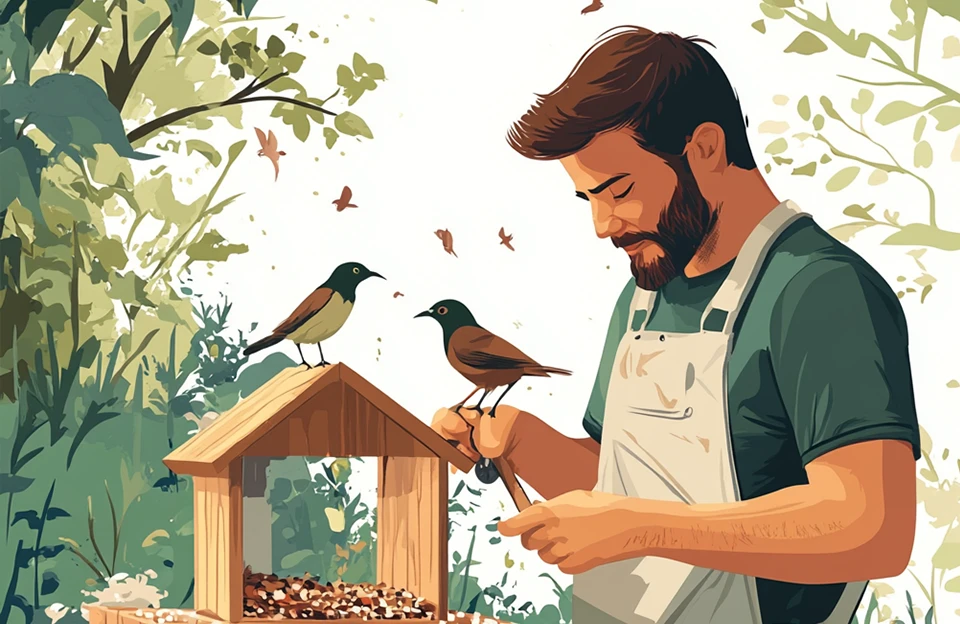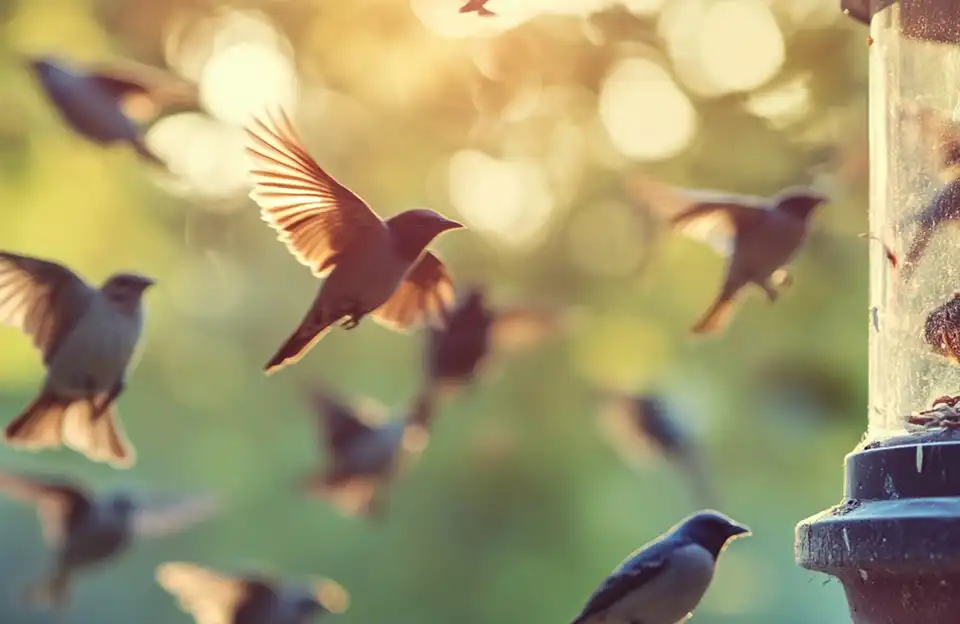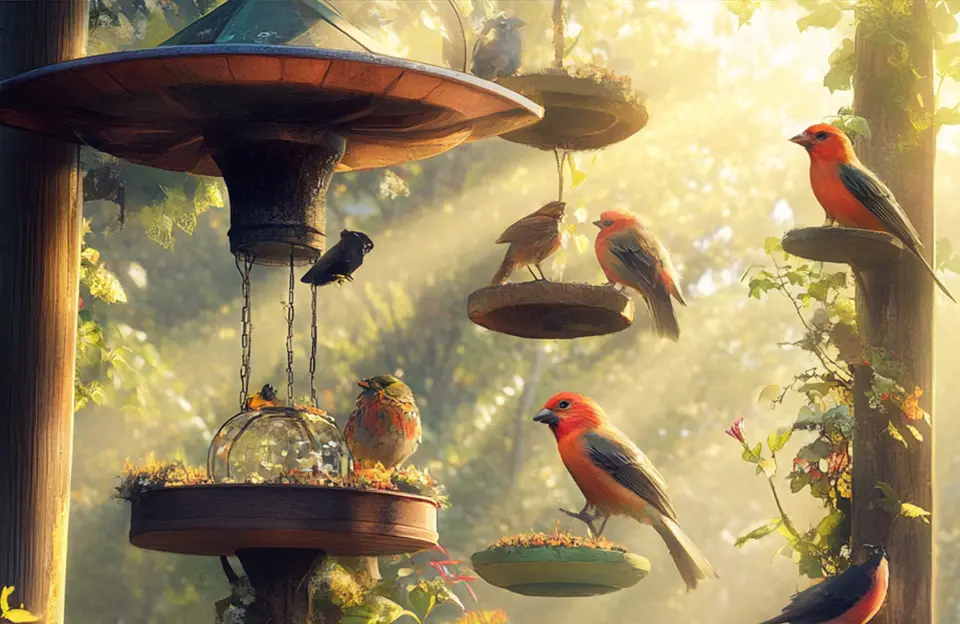Bird feeders come in a variety of materials, including wood, metal, plastic, and glass, each offering unique advantages and challenges. Wooden bird feeders, celebrated for their natural aesthetics and eco-friendliness, require consistent care to withstand weather and deter pests. Metal feeders, known for their durability, are often chosen for their resistance to rodents but can be prone to rust. Lightweight and affordable, plastic feeders are easy to handle, yet they may degrade under prolonged sunlight exposure. Glass feeders, admired for their decorative appeal and transparency, demand careful handling due to their fragility. The variety of bird feeders meets bird enthusiasts’ specific preferences and promotes ecologically sustainable practices in gardens worldwide.
Proper maintenance of bird feeders is critical for promoting bird health and maintaining a clean, safe environment. Dirty or damaged feeders can harbor mold, bacteria, and old seed residue, potentially causing harm to birds and discouraging feeding. Additionally, well-maintained feeders ensure the integrity of the food supply, attract a variety of bird species, and minimize waste. From an environmental perspective, maintaining bird feeders extends their lifespan, minimizes material waste, and supports sustainable practices that foster biodiversity and wildlife conservation. By taking the time to care for bird feeders, enthusiasts can create a thriving habitat for birds and support ecological harmony in their outdoor spaces.
1. Maintenance Tips for Wooden Bird Feeders
Wooden bird feeders are often chosen for their natural beauty and eco-friendliness. The warm, rustic appearance of wood blends seamlessly with outdoor landscapes, offering an aesthetically pleasing choice for bird enthusiasts. Additionally, many wooden feeders are crafted from sustainably sourced materials, making them an environmentally responsible option.
However, wood is vulnerable to weathering, such as cracking or warping due to moisture and temperature changes. It can also attract pests, such as termites or carpenter ants, which may damage the feeder over time. These challenges make regular maintenance crucial for maintaining wooden bird feeders’ structure and usability.
Tips:
1. Apply Waterproof Coatings to Prolong Lifespan
To protect wooden bird feeders from moisture, apply a non-toxic, weather-resistant sealant or waterproof coating. These treatments help to prevent water absorption, reducing the likelihood of warping, cracking, or mold growth. Reapply the coating annually for optimal results.
2. Regularly Clean and Dry to Prevent Mold Growth
Clean wooden feeders weekly with a solution of mild soap and water, and let them dry completely before refilling. Avoid using harsh chemicals, which can leave harmful residues. Proper cleaning helps to eliminate bacteria, mold, and seed debris that could harm birds.
3. Check for Cracks or Rot Each Season
Inspect the feeder for any signs of damage, such as cracks, splits, or rot. Repair minor issues with wood filler or sanding, and replace severely damaged feeders to avoid posing risks to birds. Ensuring structural integrity is vital for the safety and longevity of the feeder.
By following these maintenance tips, wooden bird feeders can retain their beauty and functionality while providing a safe and enduring food source for birds.
2. Maintenance Tips for Metal Bird Feeders
Metal bird feeders are known for their robust durability and resistance to rodent damage. They are often designed to withstand harsh weather conditions and prevent squirrels or other animals from chewing through the material. These qualities make metal feeders a long-lasting and reliable option for outdoor bird feeding.
Despite their strength, metal feeders are susceptible to rust and corrosion if left exposed to moisture over time. Rust weakens metal bird feeders and poses significant health risks to birds. This challenge highlights the need for proper maintenance to preserve the functionality and safety of metal bird feeders.
Tips:
1. Treat with Anti-Rust Sprays
To protect metal feeders from rust, apply a non-toxic, bird-safe anti-rust spray or coating. Focus on areas most exposed to moisture, such as joints or seams. Applying the spray regularly, particularly before the onset of rainy seasons, will significantly extend the feeder’s lifespan.
2. Fix Scratches Promptly to Prevent Further Damage
Inspect the feeder regularly for scratches or chips in the coating. These areas are vulnerable to rust. Use touch-up paint or rust-inhibiting products to repair any damaged spots immediately. Prompt action will prevent further deterioration.
3. Wash Weekly to Reduce Seed Debris Buildup
Clean the feeder weekly with a mild soap and water solution to remove seed residue and bird droppings. Rinse thoroughly and dry completely before refilling. Regular cleaning prevents the buildup of debris that could accelerate rusting or harm birds.
By following these maintenance practices, metal bird feeders can remain durable under harsh outdoor conditions while providing birds with a safe and clean feeding environment.
3. Maintenance Tips for Plastic Bird Feeders
Plastic bird feeders are favored for their lightweight design, making them easy to handle, install, and relocate. Additionally, they are often more affordable compared to metal or wooden alternatives, making them an accessible option for beginners and casual bird watchers.
Despite their advantages, plastic feeders can become brittle, discolored, or warped when exposed to direct sunlight over extended periods. This vulnerability requires strategic placement and periodic inspection to maintain their usability and appearance.
Tips:
1. Avoid Direct Sunlight; Place in Shaded Areas
Place plastic bird feeders in shaded areas to protect them from harmful UV rays, preserving their structure and extending their usability. Consider placing them under trees, porches, or using a UV-resistant cover to shield them from direct sunlight. This practice will extend their lifespan and maintain their structural integrity.
2. Clean with Mild Detergents to Avoid Surface Scratches
Wash the feeder weekly with a soft sponge and a solution of mild detergent and warm water. Avoid abrasive cleaners or rough brushes that could scratch the surface, making it more prone to damage over time. Rinse thoroughly and dry before refilling.
3. Check for Loose or Damaged Parts Regularly
Inspect the feeder regularly to ensure that all parts, such as perches, lids, and hanging hooks, are secure and functional. Replace any damaged or missing components to prevent accidents or disruptions to feeding.
By following these maintenance tips, plastic bird feeders can remain in good condition, providing a safe and reliable feeding environment for birds while enhancing the bird-watching experience for users.
4. Maintenance Tips for Glass Bird Feeders
Glass bird feeders are prized for their clarity, allowing bird watchers to enjoy unobstructed views of feeding birds. Their decorative designs often add elegance to gardens and outdoor spaces, making them as much an ornament as a functional feeder.
However, the fragility of glass poses challenges. Dropping or bumping the feeder can result in cracks or breakage, potentially harming birds or requiring replacement. This makes careful installation and handling crucial for maintaining the feeder’s longevity and safety.
Tips:
1. Clean with Warm Water and Soft Brushes
Clean glass bird feeders regularly using warm water and a soft brush or sponge. This helps remove seed debris and bird droppings without scratching the surface. Avoid using harsh chemicals that could leave residues harmful to birds. Rinse thoroughly to ensure cleanliness.
2. Avoid Impact; Choose Stable Hanging Methods
Hang glass feeders in locations where they are less likely to be knocked over by wind or animals. Use sturdy hooks or mounts to provide stability. Placing the feeder away from high-traffic areas can also reduce the risk of accidental bumps or damage.
3. Inspect for Cracks Before Each Refill
Before refilling, carefully inspect the feeder for cracks or chips. Damaged glass bird feeders pose potential risks to birds and must be repaired or replaced promptly. Regular inspections ensure the safety of the birds and maintain the aesthetic and functional quality of the feeder.
By following these maintenance tips, glass bird feeders combine decorative charm with functional reliability, offering a safe feeding environment for birds.
5. General Maintenance Tips
Cleaning Frequency: At Least Once a Week to Prevent Bacteria and Mold Growth
- Routine cleaning of bird feeders ensures a hygienic and healthy environment for birds. Dirty feeders can harbor mold, bacteria, and spoiled seeds, which can cause diseases in birds. Clean feeders with warm, soapy water at least once a week and disinfect them with a vinegar solution (one part vinegar to four parts water) or a bird-safe cleaner.
- After cleaning, rinse thoroughly and allow the feeder to dry completely before refilling it with fresh food.
Safety Inspection: Regularly Check the Feeder’s Structural Integrity to Avoid Harm to Birds
- Inspect feeders regularly for cracks, sharp edges, or loose parts that may harm birds. Loose hooks, perches, or lids should be tightened or replaced to ensure safety and functionality.
- Check feeding ports and seed reservoirs for blockages caused by wet seeds or debris. Keeping these areas clear ensures smooth feeding and reduces the risk of contamination.
Storage Recommendations: Store Feeders Indoors During Extreme Weather Seasons
- During extreme weather conditions, such as heavy rain, snow, or intense heat, consider storing feeders indoors to protect them from damage. This also helps prolong the life of feeders made of more sensitive materials like wood and plastic.
- When not in use, store feeders in a cool, dry place to prevent exposure to moisture and pests. Always ensure feeders are thoroughly cleaned and dried before storage to prevent mold growth and lingering odors.
By following these general maintenance tips, bird feeders can maintain their durability and functionality while supporting ecological harmony and providing a safe, healthy feeding environment for birds.
Choosing the right bird feeder is a personal decision influenced by factors such as material, budget, and the types of birds you wish to attract. Whether it’s a rustic wooden feeder, a durable metal design, a lightweight plastic option, or a decorative glass model, selecting a feeder that fits your unique needs and environment is the first step toward creating a thriving bird-friendly space.
However, owning a bird feeder comes with the responsibility of regular maintenance. Proper care not only extends the life of the feeder but also ensures it remains a safe and inviting space for birds. By committing to consistent upkeep, bird enthusiasts can enjoy the joys of bird watching while contributing to the well-being of local bird populations.
A well-maintained bird feeder serves as a vital resource for birds, providing them with food during challenging seasons, encouraging biodiversity, and fostering a balanced ecosystem in your backyard. It also fosters a deeper connection with nature, allowing individuals and families to appreciate the beauty and behaviors of various bird species.
Moreover, maintaining bird feeders contributes to environmental conservation by reducing waste and supporting sustainable practices. By attracting and nourishing birds, feeders play a role in pollination, seed dispersion, and pest control, which are crucial for a balanced ecosystem.
In conclusion, the combination of thoughtful selection and diligent maintenance of bird feeders allows bird lovers to create a welcoming sanctuary for their feathered friends while positively impacting the environment.




Thanks for the help in this question, the easier, the better …
Useful piece
In it something is. Many thanks for the help in this question, now I will know.